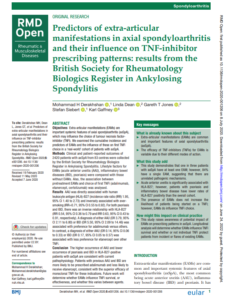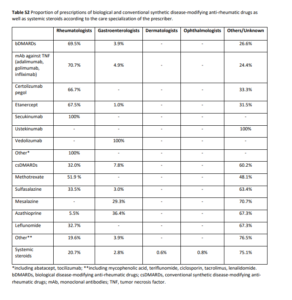
READ HERE
Data from the Screening for Axial Spondyloarthritis in Psoriasis, Iritis, and Colitis (SASPIC) Study
- Maksymowych WP, Carmona R, Yeung J, Chan J, Martin L, Aydin S, et al. THU0393 PERFORMANCE OF THE ASAS CLASSIFICATION CRITERIA PRESENTING WITH UNDIAGNOSED BACK PAIN? DATA FROM THE SCREENING IN AXIAL SPONDYLOARTHRITIS IN PSORIASIS, IRITIS, AND COLITIS (SASPIC) COHORT. Annals of the Rheumatic Diseases. 2019;78(Suppl 2):482-. https://ard.bmj.com/content/78/Suppl_2/482.1
- Maksymowych WP, Carmona R, Yeung J, Chan J, Martin L, Aydin S, et al. SAT0339 WHAT IS THE IMPACT OF IMAGING ON DIAGNOSTIC ASCERTAINMENT OF PATIENTS PRESENTING WITH UNDIAGNOSED BACK PAIN AND WHAT IS THE IMPACT OF CENTRAL EVALUATION? DATA FROM THE SCREENING IN AXIAL SPONDYLOARTHRITIS IN PSORIASIS, IRITIS, AND COLITIS (SASPIC) COHORT. Annals of the Rheumatic Diseases. 2019;78(Suppl 2):1248-9. https://ard.bmj.com/content/78/Suppl_2/1248
- Maksymowych WP, Carmona R, Chan J, Yeung J, Aydin S, Martin L, et al. SAT0383 ENHANCED PERFORMANCE OF THE ASAS CLASSIFICATION CRITERIA BY DELETION OF NON-DISCRIMINATORY CLINICAL ITEMS: DATA FROM THE SCREENING IN AXIAL SPONDYLOARTHRITIS IN PSORIASIS, IRITIS, AND COLITIS COHORT. Annals of the Rheumatic Diseases. 2020;79(Suppl 1):1140-. https://ard.bmj.com/content/79/Suppl_1/1140.1
In the multicentre Screening for Axial SpA in Psoriasis, Iritis (AAU), and Colitis cohort, 48% of people with psoriasis, AAU or colitis, ≤45 years of age with ≥3 months undiagnosed back pain were diagnosed with axial SpA if using a three-stage evaluation approach (clinical evaluation, laboratory results [HLA-B27, CRP] and radiography, MRI); 69% were diagnosed with axial SpA after the clinical evaluation alone. These figures suggest that many opportunities to identify, diagnose and treat axial SpA are being missed.
The following clinical SpA features were non-discriminatory between axial SpA/not axial SpA: NSAID response, family history of SpA, heel enthesitis, peripheral arthritis, dactylitis. This effect was particularly noteworthy in patients with lower degree of symptomatology (back pain severity <5/10), short symptom duration (<5 years) and in females. In a prospective cohort with a high pre-test probability of axial SpA certain clinical SpA features were not helpful in discriminating a diagnosis of SpA.



